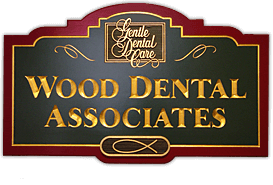Cone Beam Computed Tomography
Wood Dental Associates is extremely proud to be able to offer our patients Cone Beam Computed Tomography (CBCT) diagnostic scanning using the Galileos Comfort from Sirona, which is one of the most advanced dental scanning devices available.
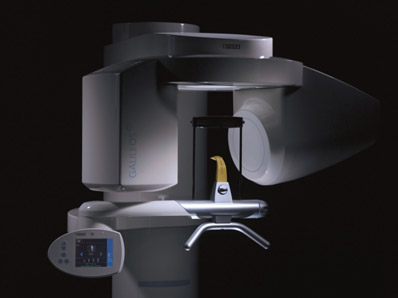
What is CBCT?
To better explain what Cone Beam CT (CBCT) is, we should first explain what regular CT is:
Computed tomography (CT) imaging, also referred to as a computed axial tomography (CAT) scan, involves the use of rotating X-ray equipment, combined with a digital computer, to obtain images of the body. Using CT imaging, cross sectional images of body organs and tissues can be produced. Though there are many other imaging techniques, CT imaging has the unique ability to offer clear images of different types of tissue. CT imaging can provide views of soft tissue, bone, muscle, and blood vessels, without sacrificing clarity. Other imaging techniques are much more limited in the types of images they can provide.
CT imaging is commonly used for diagnostic purposes. In fact, it is a chief imaging method used in diagnosing a variety of diseases, including those affecting the lungs, pancreas, and liver. CT has been used for several years in medicine, and now the technology is being harnessed to provide better imaging for dentistry, allowing us to provide our patients the highest quality of care.
So, what exactly is Cone Beam CT?
In layman's terms, CBCT is a compact, faster and safer version of the regular CT. Through the use of a cone shaped X-ray beam, the size of the scanner, radiation dosage and time needed for scanning are all dramatically reduced.
The Galileos CBCT scanner fits compactly into our office structure and is easily accessible by patients. The time needed for a full scan is typically under 20 seconds and the radiation dosage is up to a hundred times less than that of a regular CT scanner.
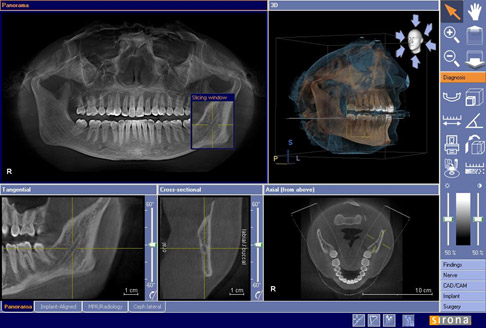
Is it painful?
No, the Galileos CBCT scan process is completely painless.
What does our CBCT equipment look like?
Our Galileos CBCT scanner is a tall, somewhat slender machine. You will stand (or in some cases sit upright) while a C-arm rotates around your head. Within the arm there is an X-ray source and detector (X-ray receiver), which will make one complete 360° rotation for each scan. While the arm is rotating, it is capturing multiple images of your head from different angles. These images are then reconstructed to create a 3D image of your internal anatomy.
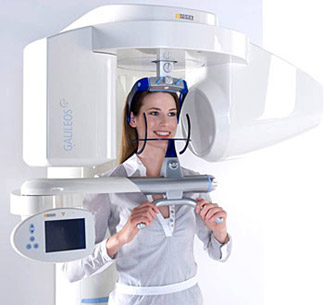
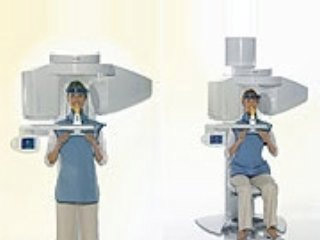
How does the CT scan help our Staff?
It allows our staff to:
- Visualize internal anatomy that cannot be diagnosed externally
- Plan treatment and surgery, including Implants
- Prepare necessary aids
- Assess risk and possible pathology and disease
- Analyze the position and orientation of critical structures, like nerves, teeth roots, previous implants, the sinuses and nose, and airway passages
What are the CBCT Scans used to diagnose and treat?
- Oral surgery
- Implant planning
- Orthodontic planning & implant anchorage
- Cephalometric analysis
- TMJ analysis
- Airway study (sleep apnea)
- Jaw tumors
- Impacted teeth
- Periodontal diseases
- Endodontic anomalies
Why a CBCT scanner rather than a regular Medical CT scanner?
- X-ray Radiation exposure to the patient is up 10 times less than a regular CT scanner.
- Much faster scan time. Scan on a CBCT takes between 10-40 sec, while on a regular CT scanner it takes a few minutes.
- Cheaper, average price of a CBCT scan could be up to 50% less than a regular MDCT scan.
What are the benefits versus risk?
Benefits
- Unlike regular X-rays, CT scans can discriminate between many types of tissue including bone, teeth, nerves and soft tissue.
- CT scans are noninvasive, and can eliminate the need for exploratory surgery in some cases.
- CT can identify the effects of conditions such as infection and tumors.
- A cost effective tool for imaging a wide range of clinical problems.
Risks
In a dosimetry study conducted by Dr. Ludlow (2007) of the University of South Carolina the Sirona Galileos has the lowest radiation dose of any cone beam machine on the market. One scan is compared to about 8 days of normal background radiation. This doesn't even mean 8 days exposed in the sun but only 8 days of normal radiation by simply living on the planet earth. As a comparison, a full mouth series of X-rays taken in a dental office using old technology X-ray films (not digital X-rays) is equivalent to 47 days of background radiation. As with all imaging modalities that use ionizing radiation, the use of CBCT does involve a consideration of risk to the patient. However, it has the benefit of providing useful information needed to assist in making a diagnosis and/or in facilitating treatment. When your doctor refers you for an X-ray examination, he has made the determination that the benefit outweighs the risk. Of course, it is ultimately up to you to decide whether to undergo the examination. Bear in mind that the risk of most X-ray examinations are much less than other risks we commonly accept in daily life.
